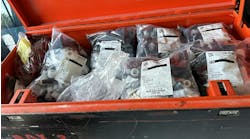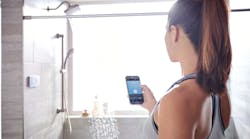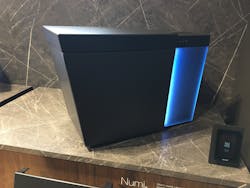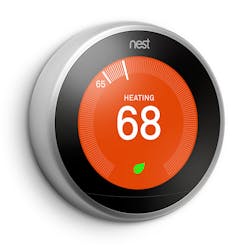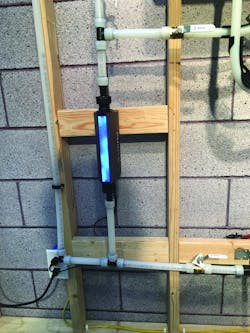Latest from Plumbing
Sponsored
It was all over this year’s AHR Expo in Chicago. At almost every booth, in nearly a dozen educational seminars, going by a hundred different names: Internet of Things, intelligent buildings, WiFi enabled, web-enabled, cloud-based, app-controlled, learning algorithm, artificial intelligence, predictive modeling… the list goes on.
Whatever you want to call it, sensors, controls and appliances are all becoming more sophisticated, all communicating with one another and with their users better, faster and easier than ever before. Industry staples that no one ever thought would need a computer chip — toilets, showers, faucets — can now upload data to the cloud and in turn be controlled from a smartphone.
In fact, one of the big stories to come out of AHR Expo 2018 was that the expo itself is getting some big competition from the annual Consumer Electronics Show! That is how more and more manufacturers of plumbing and heating equipment are starting to see themselves.
Smart choices
Think what you like about the new smart home era, there is no avoiding it. Smart technology can save consumers water and energy which all translates into saving money. More than that, consumers are being conditioned to expect a certain level of functionality and performance from all their home appliances. After all, if you can just tell your television what shows to record, your stereo what music to play, why not tell your shower what temperature you want? Your toilet how much water to flush with?
Meanwhile the technology is becoming more affordable all the time. A lot of the software is now open-source, meaning any developer can download it from the web and tweak it to suit their particular application.
The hardware is becoming more affordable as well. But beyond the price of chips and circuit boards, the not very well-kept secret about the next wave of smart home appliances is that manufacturers may begin to sell them at a deep discount or even at a loss.
And why? Because the real value is in the data these appliances will be collecting about the habits of people working and living in smart buildings. That data can be turned into even more intelligent smart home systems. That data can be turned into new products and services that deliver greater comfort to occupants, or, if you’re the owner of an office building, increase the productivity of workers. This convergence of the Internet of Things with Big Data — and it’s already starting to happen — will likely spark yet another cycle of intelligent home and building automation.
On voice command
The first wave of smart home devices to really make traction with the general public were thermostats like the Ecobee, Honywell’s Lyric and Google’s Nest. The energy savings were dramatic (to the point that utilities and municipalities were willing to subsidize retrofits) and easy to demonstrate to consumers. And the interface looked an awful lot like a smartphone, something that almost everyone was familiar with.
The new wave is tied to voice-controlled speakers like Amazon Echo and Google Home. According to a post-CES report by the Consumer Technology Association, sales of voice-controlled speakers increased 279 percent last year and are projected to reach sales of 44 million units this year — a 60 percent increase.
For Google, it’s a natural convergence that can now put their technology in charge of a home’s temperature, lighting and security, all operated by a homeowner’s voice commands.
Moen has recently introduced the U by Moen shower that is voice activated by Amazon Alexa. The WiFi/cloud based shower includes a digital valve that offers precise, thermostatic control and enables the user to connect up to four shower devices (showerheads, handshowers, body sprays, etc.). It features a five-inch, non-touch, LCD screen for feedback on shower status through on-screen messaging and notifications.
The U by Moen smartphone app (and yes, everybody has an app to go with their appliance) gives the users the ability to create up to 12 personalized presets, including name, greeting, outlets, temperature, shower timer and more.
Manufacturers are going to extreme lengths to make sure their products get installed correctly and work as advertised.
The Kohler Konnect from Kohler Co. is capable of supporting multiple voice services. Users can operate the kitchen faucet, control features of an intelligent toilet, adjust the lighting embedded in a bathroom mirror, run a shower or fill a bath, all via voice command (or through hands-free motion control). It uses the global-scale Microsoft Azure cloud platform, and Kohler is offering support for use with Amazon Alexa, Google Assistant and Apple HomeKit.
“Voice services and connected devices have become integrated into every facet of the home – with the notable exception of the bathroom, until now,” said David Kohler, President and CEO of Kohler Co. “We provide thoughtful design and technologies that offer convenience and functionality to enrich your personalized experiences.”
According to Ken Sinclair, publisher of AuotmatedBuildings.com (and regular columnist for CONTRACTOR Magazine’s Connected Contractor eNewsletter), “Voice becomes the lowest cost set up tool, and when coupled with the ubiquitous cell phone it is cheaper than touch screens or even old-school buttons and switches. I am very impressed with how easily it allows very different things to be grouped into one simple spoken command. The amazing connections between entertainment, education, and more give it an immediate value that is so easy to build on.”
Behind the walls
But the smart home movement is about more than giving users functionality and control. It’s also about taking those elements of a built environment that are vitally important but usually invisible and bringing them to the attention of the proper controlling authority, whether that be a human on-site, a human at some remote location, or a decision-making algorithm up in the cloud.
To go back to the thermostat as an example, no one usually realizes exactly how much heating unoccupied rooms is costing them, they’re just upset when a huge energy bill shows up. But if a smart thermostat can generate an energy usage report with easy-to-read graphics, suddenly the potential savings becomes visible.
Smart devices are now available that can monitor a home’s entire water system.
The Phyn Plus from Uponor begins to learn about the home’s water system as soon as it’s installed. It a automatically measures tiny changes in water pressure, 240 times per second.
When it notices abnormal water usage, Phyn’s mobile app alerts homeowners in real-time and, in the event of a major leak, like a pipe burst, can turn off water automatically with its built-in shutoff valve. Daily diagnostic “Health Checks” help detect irregular pressure levels and potential ultra-low leaks, helping to prevent future issues.
Streamlabs is a new water technology company was born out of Reliance Worldwide Corporation’s acquisition in November 2016 of Soneter, a Georgia Tech startup founded in 2010. The company’s inaugural offering is the Smart Home Water Monitor, a non-invasive device that offers early leak defense and water monitoring capabilities, again through a mobile app compatible with both iOS and Android devices. The monitor uses ultrasonic technology to obtain accurate flow data. The data will be recorded by the monitoring system, where it can be easily accessed by the end user.
Systems like this have the potential to save homeowners thousands of dollars in repair costs. The Insurance Journal rates internal water leaks at a more frequent risk that fire or theft.
Don’t fear the wire (or the data cable)
There is a certain school of thought among some plumbers that goes something like this: if water’s flowing through it, that’s my job. If it’s made of wood, that’s the carpenter’s job. And if it runs on electricity that’s the electrician’s job.
Yes, the new wave of smart home technology is going to require some adaptation and training on the part of installers. But the benefits to the customers — and the resulting profits to be made — more than make up for the trouble.
If you can handle wiring for a simple control or work your way through the setup wizard screen on one of the new-model water heaters, you’re probably going to be able to handle most smart home devices. Most manufacturers are going out of their way to make sure their devices are easy to install, or, if that’s not possible, that proper training is easy to access.
In fact, manufacturers are going to extreme lengths to make sure their products get installed correctly and work as advertised. After all, this is the consumer electronics market now. To take the so-called “cult of Apple,” as an extreme example, this is about building a relationship between a consumer and a brand via the product. If the product doesn’t work as advertised it’s the manufacturer who usually gets blamed, not the installer.
For a simple example, the U Moen shower discussed above offers a 30-ft. data cable between the digital valve and the controller so it can be put wherever is most convenient for both the plumber and the homeowner.
For the Phyn Plus, Uponor has created a special program called their Pro Squad. Only licensed plumbing professionals who are accepted into the program and receive comprehensive training — including requirements tied to sales, customer satisfaction and service delivery — are able to sell and install the system. Uponor and the Phyn company then go on to provide technical support to Pro Squad members. Pro Squad members will also get the first look at the company’s next generation of smart plumbing devices.
These are exciting times for the industry. What is now remarkable will soon — sooner than you might imagine — become commonplace. Maybe the idea of talking to a toilet seems silly now, but in a decade or so there will be some young people who will be shocked when the toilet doesn’t talk back.
Steve Spaulding | Editor-inChief - CONTRACTOR
Steve Spaulding is Editor-in-Chief for CONTRACTOR Magazine. He has been with the magazine since 1996, and has contributed to Radiant Living, NATE Magazine, and other Endeavor Media properties.
